I have a function r(x) that I want to rotate around the x axis to get a solid of revolution that I want to add to an existing plot_ly plot using add_surface (colored by x).
Here is an example:
library(dplyr)
library(plotly)
# radius depends on x
r <- function(x) x^2
# interval of interest
int <- c(1, 3)
# number of points along the x-axis
nx <- 20
# number of points along the rotation
ntheta <- 36
# set x points and get corresponding radii
coords <- data_frame(x = seq(int[1], int[2], length.out = nx), r = r(x))
# for each x: rotate r to get y and z coordinates
# edit: ensure 0 and pi are both amongst the angles used
coords %<>%
rowwise() %>%
do(data_frame(x = .$x, r = .$r,
theta = seq(0, pi, length.out = ntheta / 2 + 1) %>%
c(pi + .[-c(1, length(.))]))) %>%
ungroup %>%
mutate(y = r * cos(theta), z = r * sin(theta))
# plot points to make sure the coordinates define the desired shape
coords %>%
plot_ly(x = ~x, y = ~y, z = ~z, color = ~x) %>%
add_markers()
How can I generate the shape indicated by the points above as a plotly surface (ideally open on both ends)?
edit (1):
Here is my best attempt so far:
# get all x & y values used (sort to connect halves on the side)
xs <-
unique(coords$x) %>%
sort
ys <-
unique(coords$y) %>%
sort
# for each possible x/y pair: get z^2 value
coords <-
expand.grid(x = xs, y = ys) %>%
as_data_frame %>%
mutate(r = r(x), z2 = r^2 - y^2)
# format z coordinates above x/y plane as matrix where columns
# represent x and rows y
zs <- matrix(sqrt(coords$z2), ncol = length(xs), byrow = TRUE)
# format x coordiantes as matrix as above (for color gradient)
gradient <-
rep(xs, length(ys)) %>%
matrix(ncol = length(xs), byrow = TRUE)
# plot upper half of shape as surface
p <- plot_ly(x = xs, y = ys, z = zs, surfacecolor = gradient,
type = "surface", colorbar = list(title = 'x'))
# plot lower have of shape as second surface
p %>%
add_surface(z = -zs, showscale = FALSE)
While this gives the desired shape,
- It has 'razor teeth' close to the
x/yplane. The halves parts don't touch.(resolved by including0andpiin thethetavectors)I didn't figure out how to color it by(resolved byxinstead ofz(though I didn't look much into this so far).gradientmatrix)
edit (2):
Here is an attempt using a single surface:
# close circle in y-direction
ys <- c(ys, rev(ys), ys[1])
# get corresponding z-values
zs <- rbind(zs, -zs[nrow(zs):1, ], zs[1, ])
# as above, but for color gradient
gradient <-
rbind(gradient, gradient[nrow(gradient):1, ], gradient[1, ])
# plot single surface
plot_ly(x = xs, y = ys, z = zs, surfacecolor = gradient,
type = "surface", colorbar = list(title = 'x'))
Surprisingly, while this should connect the two halves orthogonal to the x / y plane to create the full shape,
it still suffers from the same 'razor teeth' effect as the above solution:
edit (3):
It turns out the missing parts result from z-values being NaN when close to 0:
# color points 'outside' the solid purple
gradient[is.nan(zs)] <- -1
# show those previously hidden points
zs[is.nan(zs)] <- 0
# plot exactly as before
plot_ly(x = xs, y = ys, z = zs, surfacecolor = gradient,
type = "surface", colorbar = list(title = 'x'))
This could be caused by numerical instability of the substraction when r^2 and y get too close, resulting in negative input for sqrt where the actual input is still non-negative.
This seams unrelated to numerical issues as even when considering +-4 'close' to zero, the 'razor teeth' effect can not be avoided completely:
# re-calculate z-values rounding to zero if 'close'
eps <- 4
zs <- with(coords, ifelse(abs(z2) < eps, 0, sqrt(z2))) %>%
matrix(ncol = length(xs), byrow = TRUE) %>%
rbind(-.[nrow(.):1, ], .[1, ])
# plot exactly as before
plot_ly(x = xs, y = ys, z = zs, surfacecolor = gradient,
type = "surface", colorbar = list(title = 'x'))








